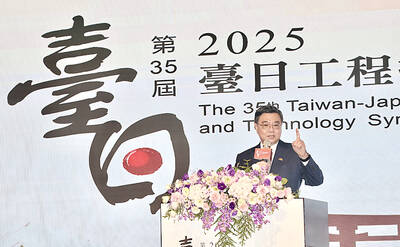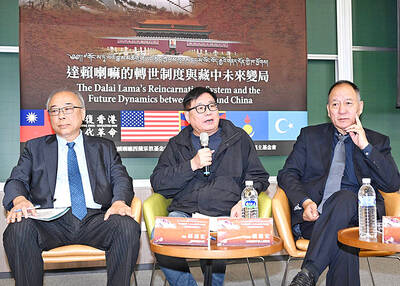The Danjiang Bridge project, which has been postponed for more than a decade, will be reviewed by the Environmental Impact Assessment (EIA) Committee again at the end of this month, the Directorate-General of Highways (DGH) said yesterday.
Lee Chung-chang (李忠彰), director of the agency’s planning and design division, said the 900m Danjiang Bridge would span the Tamsui River, connecting Lingang Boulevard along Taipei Port and Shalun Road in Tamsui (淡水), New Taipei City (新北市).
From Shalun Road, drivers would be able to continue driving north to No. 1-3 road in Danhai New Township (淡海新市鎮), Lee said. The entire route from Taipei Port to the Danjiang Bridge to No.1-3 Road in Danhai New Township is approximately 6km, he said.
The agency said residents in those areas would no longer need to detour over the Kuangdu Bridge when traveling between Bali and Tamsui once the Danjiang Bridge is built. Travel distances would be cut by 15km, which will in turn reduce travel time by between 20 and 30 minutes, the agency said.
Lee said that both local and foreign design teams were welcome to pitch ideas for the bridge’s design.
The agency had planned to build a cable-stayed bridge, with the cables supporting the bridge deck being attached to diamond-shaped towers, Lee said.
“The sunset at Tamsui is one of the nation’s eight fantastic scenes. We have talked with environmental activists, who were concerned that the scene might be spoiled by the bridge,” Lee said. “What we want is a bridge that fits in well with the natural and cultural scenery in these areas.”
Once completed, the bridge would be the nation’s first to feature light-rail tracks and the roads side by side.
Lee said the bridge would be 44m wide and 20m high. It would feature a bike lane and a pedestrian pathway, and 8m of its width would be reserved for light rail tracks, he said.
The bridge’s construction cost is estimated at more than NT$15.4 billion (US$522.5 million), including the additional funding needed to expand its width.
Once the project wins EIA approval, the agency said it would take six years from expropriating the required land to designing and building the bridge.
Planning for the bridge project was completed in 1998 and then approved at the EIA in 1999. However, the EIA rejected the construction of an expressway along the north side of the Tamsui River in 1999.
Because of the ruling, the agency decided to postpone construction after reconsidering the cost and actual benefits if the bridge was built without a connecting expressway.
It reviewed the project after Provincial Highway 64, which connects Bali and Sindian (新店), became operational in 2008. The agency then decided to adjust the project by changing the designs of the express lanes in Bali and Danshuei leading to the bridge and by reserving space on the bridge for the construction of the light rail tracks to Danhai New Township.
The Environmental Impact Assessment Act (環境影響評估法) requires project developers to submit an analysis on the changes to a project’s environmental impact if they alter the project’s design.

ALIGNED THINKING: Taiwan and Japan have a mutual interest in trade, culture and engineering, and can work together for stability, Cho Jung-tai said Taiwan and Japan are two like-minded countries willing to work together to form a “safety barrier” in the Indo-Pacific region, Premier Cho Jung-tai (卓榮泰) yesterday said at the opening ceremony of the 35th Taiwan-Japan Modern Engineering and Technology Symposium in Taipei. Taiwan and Japan are close geographically and closer emotionally, he added. Citing the overflowing of a barrier lake in the Mataian River (馬太鞍溪) in September, Cho said the submersible water level sensors given by Japan during the disaster helped Taiwan monitor the lake’s water levels more accurately. Japan also provided a lot of vaccines early in the outbreak of the COVID-19 pandemic,

Kaohsiung Mayor Chen Chi-mai (陳其邁) on Monday announced light shows and themed traffic lights to welcome fans of South Korean pop group Twice to the port city. The group is to play Kaohsiung on Saturday as part of its “This Is For” world tour. It would be the group’s first performance in Taiwan since its debut 10 years ago. The all-female group consists of five South Koreans, three Japanese and Tainan’s Chou Tzu-yu (周子瑜), the first Taiwan-born and raised member of a South Korean girl group. To promote the group’s arrival, the city has been holding a series of events, including a pop-up

The Ministry of Foreign Affairs (MOFA) yesterday voiced dissatisfaction with the Comprehensive and Progressive Agreement for Trans- Pacific Partnership (CPTPP), whose latest meeting, concluded earlier the same day, appeared not to address the country’s application. In a statement, MOFA said the CPTPP commission had "once again failed to fairly process Taiwan’s application," attributing the inaction to the bloc’s "succumbing to political pressure," without elaborating. Taiwan submitted its CPTPP application under the name "Separate Customs Territory of Taiwan, Penghu, Kinmen and Matsu" on Sept. 22, 2021 -- less than a week after China

TEMPORAL/SPIRITUAL: Beijing’s claim that the next Buddhist leader must come from China is a heavy-handed political maneuver that will fall flat-faced, experts said China’s requirement that the Dalai Lama’s reincarnation to be born in China and approved by Beijing has drawn criticism, with experts at a forum in Taipei yesterday saying that if Beijing were to put forth its own Dalai Lama, the person would not be recognized by the Tibetan Buddhist community. The experts made a remarks at the two-day forum hosted by the Tibet Religious Foundation of His Holiness the Dalai Lama titled: “The Snow Land Forum: Finding Common Ground on Tibet.” China says it has the right to determine the Dalai Lama’s reincarnation, as it claims sovereignty over Tibet since ancient times,